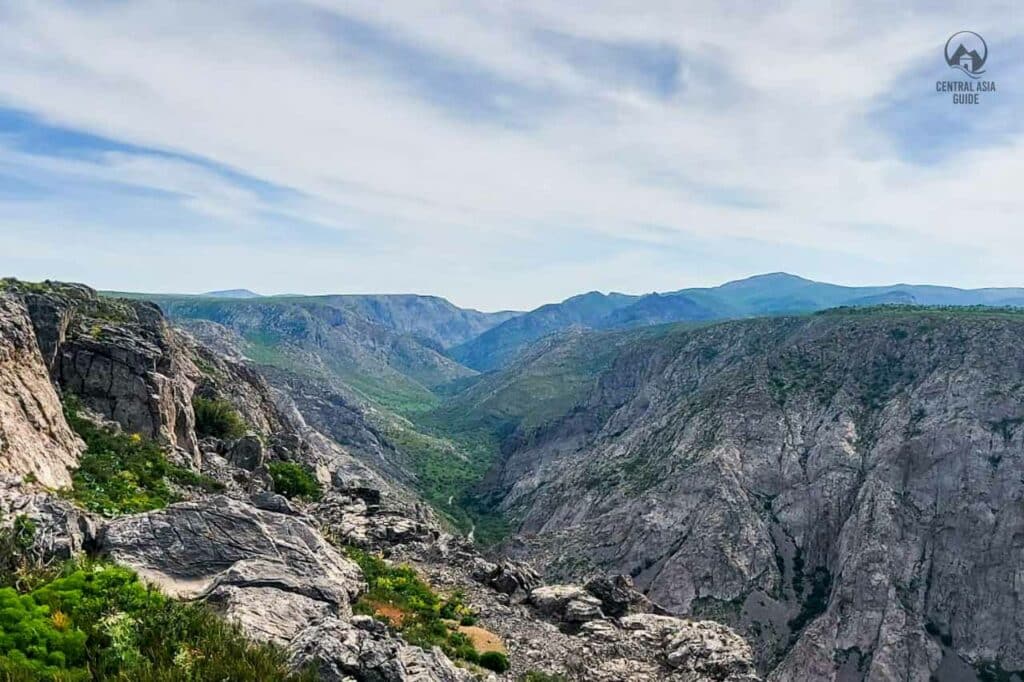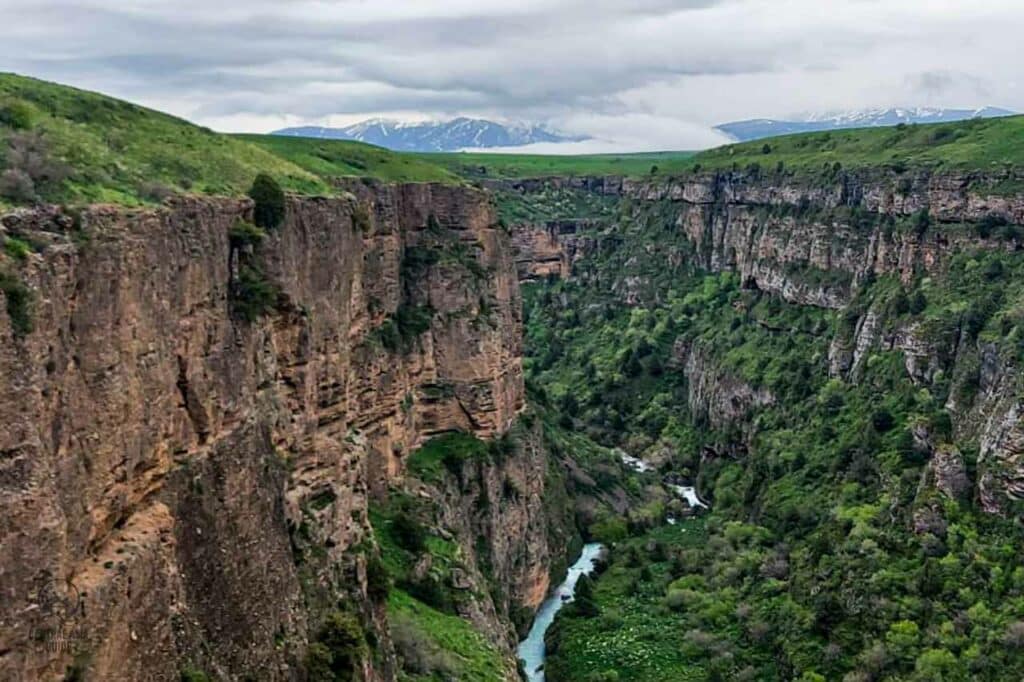A day hike tour to Aksu Canyons
Tour from Shymkent to canyon Aksu
Tour Details
-
Period
Spring - Autumn -
Tour length
1 day -
Price from
$200 per group (1 - 4 pax)
Aksu Canyon Tour Highlights
Discover the deepest canyon in Central Asia, Aksu Canyon (500m deep, 30km long), just 75 km from Shymkent. Along the way, see the medieval minaret of a historic mosque and explore an underground tunnel with a rushing mountain stream.
Enjoy a walking tour through the canyon, with views of the stunning emerald-green Aksu River, followed by a picnic. Visit the nearby Mashat Canyon for a light walk and end the day with a cozy bonfire and hot tea before returning to Shymkent. Perfect for nature and adventure lovers!


Aksu Canyon from Shymkent Itinerary
Start your journey from Shymkent to the beautiful Aksu Canyon, located 75 km away. Along the way, enjoy a stop to see the medieval minaret of a historic, ruinous mosque.
Upon arrival, explore an underground tunnel with a rapid mountain stream flowing through it. Then, take a walking tour of Aksu Canyon, the deepest canyon in Central Asia with stunning views of the emerald-green Aksu River. Enjoy a hike and a picnic surrounded by breathtaking nature.
Continue to Mashat Canyon for a relaxing walk in a peaceful setting. End the day with a bonfire and hot tea before returning to Shymkent, completing a memorable adventure in Kazakhstan’s stunning landscapes.
Tour Information
INCLUDED
- Transfers
- English speaking guide
NOT INCLUDED
- Entrance fee
- Lunch
- Personal expenses
(Entrance fee and lunch will be an extra 30USD)
Price per group
1 – 4 people (one car) 200 USD
CHECK VISA POLICY
Find your country from the list and check possible visa requirements for Kazakhstan
BOOK YOUR TOUR HERE
If you would like to customize your tour, please don’t hesitate to contact us. We are happy to organize a custom tour or to provide a modified itinerary based on one of the tours provided by our tour operators.
Tajikistan travel information

Money & costs

Safety
Entry & exit

Best time to go

Health

Money & costs
Money & costs
Tajikistan operates on the somoni (TJS) as its official currency, although dollars are accepted in some locations. However, the somoni is the primary currency for day-to-day transactions.
Cash withdrawals from ATMs can pose challenges, so it’s recommended to carry some cash to avoid any financial inconveniences. ATMs are accessible in cities such as Dushanbe, Panjakent, Khujand, Khorog, Isfara, Istaravshan, Kurgan-Tube, and even in smaller towns, excluding Murghab.
Eskhata Bank in Dushanbe is considered a reliable option for obtaining US dollars, with a generous withdrawal limit in somoni. However, be aware that ATMs may be less available on weekends. Finding an ATM that accepts Mastercard can be a bit tricky.
Both US dollars and euros are widely acknowledged across Tajikistan. In rural areas lacking formal currency exchange services, people may prefer dollars over euros. It’s essential to note that engaging in currency exchange on the black market is illegal.

Safety
Safety
While the overall security situation is generally stable and Dushanbe is considered relatively safe, occasional incidents of robbery and petty crimes may occur. Individuals with financial resources, including foreigners, could be potential targets. Here are some further recommendations for Tajikistan:
- Always carry a copy of the photo page of your passport, as authorities may request identification.
- Exercise caution by avoiding demonstrations or large gatherings, and maintain vigilance in public spaces.
- For your safety, do not leave your drinks unattended, decline beverages from strangers, and be mindful of your alcohol consumption.
- If you experience being followed or harassed at the airport, promptly report the incident to your tour agent or the consulate office at the airport.
- Show respect for local traditions, customs, laws, and religions at all times.
- Smoking is prohibited while walking on the streets.
- The possession and use of drugs are strictly illegal.
- Women traveling alone in Tajikistan may encounter unwanted attention, harassment, or gender-related difficulties.
- Photographing anything related to the military or security services may lead to complications with local authorities.
- Same-sex sexual relationships are not illegal according to Tajikistan’s legislation. However, conservative local views and levels of tolerance may vary, especially outside major cities.
- Transportation in Tajikistan often involves poorly maintained vehicles, and driving standards are basic. Gas stations outside cities are rare, and emergency services may not be readily available. Ensure you have all necessary supplies for your trip and anticipate potential delays.
- Roads outside major cities are in poor condition and may only be accessible to four-wheel-drive vehicles. Conditions are particularly hazardous in spring due to the risk of avalanches and landslides.
- Tajikistan commonly experiences shortages of energy and water, along with frequent power outages, especially during winter and spring, mostly outside Dushanbe.
- Avoid traveling to the border area with Afghanistan due to the unstable security situation.
- Despite a ceasefire agreement, the security situation remains unstable following military clashes in the Sughd region (Northern Tajikistan), bordering Kyrgyzstan, in September 2022. Khujand is still safe to visit.
- Tajikistan is prone to earthquakes, avalanches, landslides, and floods.
Entry & exit
Entry & exit
Starting from 2022, visitors from 52 countries can enjoy visa-free travel to Tajikistan. For comprehensive visa information, refer to this link. It is crucial to leave Tajikistan before your visa or visa-free entry expires to avoid penalties and the need for an exit visa.
For those planning to explore the Gorno-Badakhshan Autonomous Region (GBAO), obtaining permission is mandatory. Keep in mind that Tajikistan’s borders might close unexpectedly. Declare large amounts of imported funds upon arrival, and when departing, present the customs declaration form.

Best time to go
Best time to go
The ideal time for exploring Tajikistan is during the spring and autumn months, specifically in April, May, June, September, and October. Summers in Tajikistan are characterized by dry and intense heat, with temperatures soaring up to 40°C in the lowlands. Winters can be extremely cold, reaching -20°C in mountainous areas, and heavy snowfall in the western region may disrupt winter routes and close high-altitude mountain passes.
September stands out as perhaps the most favorable time for a journey to Tajikistan, as the heat subsides on the plains, and nearly all but the highest mountain passes remain accessible. Markets come alive with an abundance of delicious fresh produce, and the landscape transforms into a stunning golden autumn. The best time to visit Pamir is in August.

Health
Health
Before embarking on your journey, verify that your chosen destination can offer the required medical assistance you might need. Make sure you possess suitable travel insurance covering both on-site treatment and unexpected medical evacuation. If directed to a medical facility for treatment, promptly contact your insurance provider.
Tajikistan possesses limited medical facilities and faces shortages of essential medications. Medical establishments outside Dushanbe tend to be basic, with some areas having virtually no medical infrastructure.
Certain medications containing codeine are strictly prohibited in Tajikistan. If you intend to bring medications, ensure their legality and acquaint yourself with relevant regulations. Declare all medications and other restricted items upon your arrival.
Ticks are prevalent in forests and rural areas from spring to autumn. The improper disposal of uranium and pesticides in the northern Sughd region poses potential health hazards. It is advisable to get vaccinated at least against Hepatitis A, B and Tetanus at a minimum before your trip.
Tours in Kazakhstan and Central Asia
Page updated 27.1.2025